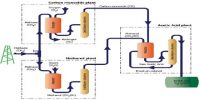These are of major importance as fuels for spark-ignition engines. One often encounters `E85′ and so on, signifying a particular percentage of alcohol, balance gasoline. Ethanol gasoline blends across the composition range will be discussed in this section.
The specification EXY, where for E85 X denotes 8 and Y denotes 5, is a nominal one, with the numeral representing only approximately the percentage of alcohol We have seen that the vapour pressure of an ethanol gasoline is important and that the RVP might require seasonal adjustment. The vapour pressure has to be adjusted by means of the ratio of gasoline to alcohol. This is the basis of ASTM classifications of such fuels, some examples of which taken from are given below.

Note that the vapour pressures are all in significant excess of that of ethanol alone at 38°C, indicating that the gasoline is raising the vapour pressure. Note the consistency between the vapour pressures in the table above and those given in a range of gasolines.
When E85 fuel is manufactured, it is to target octane rating and target vapour pressure. In order fully to specify such a fuel both the nominal proportion of ethanol and the volatility class need to be known. This can be more fully understood by reference to a study in 2006 of samples of E85 obtained from outlets in ten states of the US9. It is reported in that the E85 samples of volatility class 1 had a median alcohol content of 81.6% and a median vapour pressure of 41.7 IcPa.
The ethanol content is just below the nominal one of 85% and just above the value which corresponds to the vapour pressure according to the ASTM classification of volatilities in the above table.











